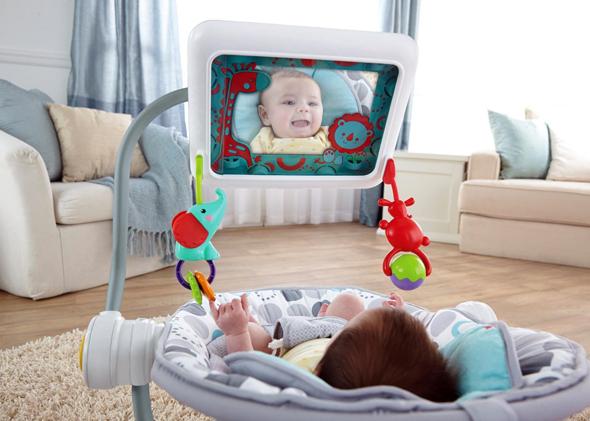Right around Black Friday, my Facebook wall lit up with scorn for a new product that had appeared on Amazon. “End times,” wrote a parent pal, who linked to the Fisher-Price iPad Apptivity Seat, Newborn-to-Toddler. Fresh out of the oven, your child can get addicted to the beauteous simplicity of Apple’s app functionality. This is probably why Steve Jobs invented the iPad: So our lil’est consumers could learn how to make in-app purchases before they can spell their names. Don’t worry, the stand has a case “to protect from dribbles and drool.” Amazon even selected this product as one of the best gifts for kids in 2013. Amazon reviewers weighed in as well:
As most parents of small children know, the American Academy of Pediatrics recommends that children under 2 avoid screen time. While there are few parents who haven’t calmed a shrieking toddler with an iPhone or cracked under the strain of a rainy Saturday afternoon and put on some old-school Sesame Street for their tots, it seems at best perverse, and at worst mildly harmful, to offer such a high-tech visual product geared toward children who can’t even hold their heads up or see things that are more than a few feet away.
And yet, baby and toddler iPad accessories are a small but popular—and growing—segment of the booming tablet accessory market, which increased from $900 million in 2011 to $1.35 billion in 2012. According to Common Sense Media, 38 percent of children under 2 have used a mobile device for media this year, up from 10 percent two years ago.
Arguably the most infamous product in the toddler iPad accessory field is CTA Digital’s iPotty, which is exactly what it sounds like: a training potty with an iPad stand. Like the Fisher-Price Apptivity Seat, the iPotty also has a clear case to guard “against smudges and messy hands,” which is even more important in such close proximity to poop. Though the iPotty has been met with scorn from Amazon reviewers (“With this item, your capacity to ‘get s*** done’ is increased exponentially,” one wrote), it has been one of the company’s best sellers, says Lois Eiler, a marketing associate at CTA Digital. Eiler didn’t give me exact figures, but one might guess the iPotty is doing well, because the company just came out with a similar product, an iRocking Play Seat for iPad with Feeding Tray.
When I’ve told people about the iPotty, their reaction is generally, “What?!? Why?!?” So I asked Eiler how the company came up with the notion of bathroom Internetting for the under-3 set. She said there wasn’t really any market research before they came up with the product, but the developers had noticed that potty training apps were cropping up. The parents on the CTA Digital development team thought the iPotty would be a good companion for those apps. After all, the company already had a product line of Nickelodeon-branded tech products geared toward young children, including the Dora the Explorer Inflatable Sports Car for iPad. The iPotty debuted at CES, the enormous tech industry trade show, in January 2013 and went viral; Eiler says the reaction at CES inspired the company to bring the product to the market.
I asked Eiler about criticisms of such products. (As one commenter on Amazon put it, “Parenting at the laziest level imaginable! Keep the distracting electronics away from teaching your child lessons in life. Give them YOUR full attention!”) Eiler replied, “We never claim to be doctors or psychiatrists or any of that. Our job is to produce products that are useful to people and that people want.” She added that CTA Digital has heard from parents of special-needs kids on the autism spectrum who say that the iPotty has been instrumental in helping their kids learn how to toilet train. Finally, she pointed out that kids generally potty train when they are 22-to-30 months old, so the no-screens-under-2 prohibition doesn’t necessarily apply to the iPotty.
But those criticisms do apply to the Fisher-Price iPad Apptivity Seat, which is geared toward infants. When I asked about these complaints, Fisher-Price’s PR rep sent me a statement from Kathleen Alfano, senior director of child research. According to Alfano, “We know the Apptivity Seat isn’t for everyone, but we created the iPad feature for those times when parents want to use this option as another way to stimulate and engage their baby.” Additionally, she wrote, “When infants and toddlers are exposed to age-appropriate media with an adult present interacting with the child, explaining the content and encouraging play, media viewing can result in a positive play experience.” Fisher-Price also made clear that there are no studies showing that iPads are harmful to children’s vision.
Perhaps it’s fatalistic, but parents who are going to leave their kids in front of screens all day are going to do so whether they have an iPad stand with a comfy rocking chair attached or not. And in a tech-saturated world, not all exposure to devices at a young age is necessarily negative. As Hanna Rosin pointed out in an Atlantic article about toddlers and touch-screens, “The statement from the American Academy of Pediatrics assumes a zero-sum game: an hour spent watching TV is an hour not spent with a parent. But parents know this is not how life works.”
Which is to say, as long as you are still interacting with your kid—and not just letting her play with an iPad for all of her waking hours—it’s not necessarily the “end times” that my Facebook friend predicted. Still, we can all agree that having your iPad anywhere near a toddler in the middle of toilet training is beyond foul.
